Toniniopsis dissimilis Gerasimova & A. Beck
in Gerasimova & al., Lichenologist, 53: 176, 2021.
Synonyms:
Distribution:
Description: Thallus crustose to subsquamulose, episubstratic, grey-green or brown-green, continuous to tuberculate or warted, sometimes consisting of an appressed and continuous crust of small squamules, the warts often merging and forming a thick, wrinkled, irregularly shaped surface. Apothecia lecideine, (0.2-)0.3-0.5(-0.7) mm across, the disc grey-brown, dark brown to black (often piebald), epruinose, flat to finally convex, sometimes tuberculate disc, the proper margin distinct, concolorous or paler, finally often excluded. Proper exciple 30-115 μm wide laterally, sometimes with minute crystals not dissolving in K, the inner part pale brown (paler than hypothecium), K+ purplish brown, N+ orange-red, often with a green or blue-green tinge at least in upper part, with 2-3 layers of enlarged cells, the outer rim colourless to blue- or green-grey; epithecium grey-green to blue-green, scarcely differentiated from the hymenium, K- or K+ purple, N+ purple; hymenium colourless, without crystals, (51-)55-80(-122) μm high; paraphyses simple or bifurcate in upper part, 1.5-3.5 μm thick at mid-level, the apical cells not swollen or up to 4 μm wide; hypothecium brown to dark brown, rather thick, gradually merging into the coloration of the lower part of exciple, K+ intensely brown to purplish. Asci 8-spored, clavate, surrounded by a gelatinous I+ blue coat, with a well-developed I+ blue tholus, an I+ darker blue tube and a well-developed ocular chamber, Bacidia-type. Ascospores (1-)2-6(-7)-septate, hyaline, bacilliform, straight to sigmoid, (14-)22-31(-44) x (1.5-)2-3(-3.5) μm. Photobiont chlorococcoid, the cells 5-12 μm in diam. Spot tests: thallus K-, C-, KC-, P-, UV-. Chemistry: thallus without lichen substances; apothecia with the Bagliettoana-green pigment in epithecium and rim of exciple; Laurocerasi-brown pigment in hypothecium and lateral part of exciple.Note: a recently-described epiphytic species, known from Turkey and from several localities in Central and Northern Europe, apparently most frequent on Fraxinus and rarer than the very similar T. separabilis. For further details see Gerasimova & al. (2021). To be looked for in Italy.
Growth form: Crustose
Substrata: bark
Photobiont: green algae other than Trentepohlia
Reproductive strategy: mainly sexual

Predictive model
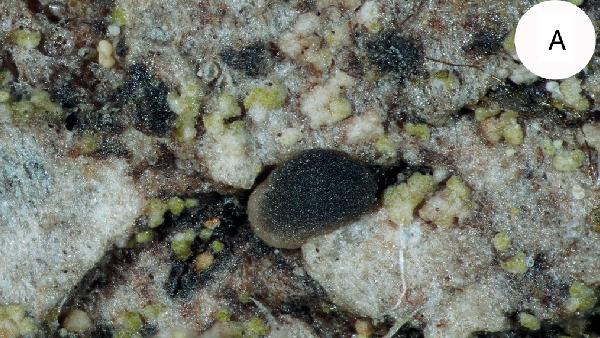
Source: Gerasimova JV, Urbanavichene IN, Urbanavichus GP, Beck A. Morphological and phylogenetic analyses of Toniniopsis subincompta s. lat. (Ramalinaceae, Lecanorales) in Eurasia. The Lichenologist. 2021;53(2):171-183. doi:10.1017/S0024282921000013 - CC BY-NC-ND 4.0
A, holotype of T. dissimilis (M-0290432, JG149); thallus, consisting of scattered ±rounded or flattened or subsquamulose granules, and dark apothecia with light brown margin - Scale: 0.5 mm
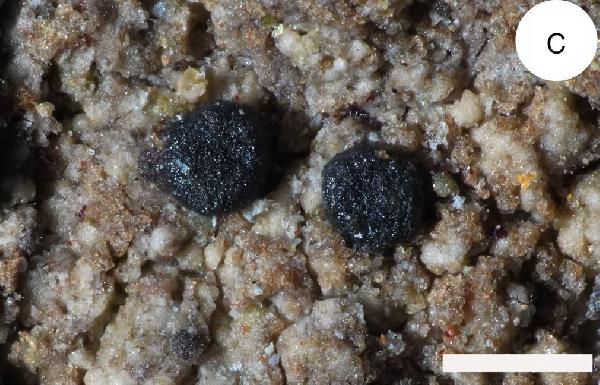
Source: Gerasimova JV, Urbanavichene IN, Urbanavichus GP, Beck A. Morphological and phylogenetic analyses of Toniniopsis subincompta s. lat. (Ramalinaceae, Lecanorales) in Eurasia. The Lichenologist. 2021;53(2):171-183. doi:10.1017/S0024282921000013 - CC BY-NC-ND 4.0
T. dissimilis (LE L-15293, JG153); thallus thick, warted to wrinkled. - Scale: 0.5 mm
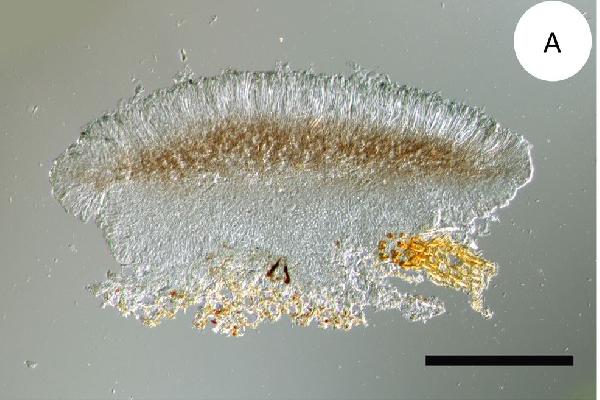
Source: Gerasimova JV, Urbanavichene IN, Urbanavichus GP, Beck A. Morphological and phylogenetic analyses of Toniniopsis subincompta s. lat. (Ramalinaceae, Lecanorales) in Eurasia. The Lichenologist. 2021;53(2):171-183. doi:10.1017/S0024282921000013 - CC BY-NC-ND 4.0
A, holotype of T. dissimilis (M-0290432, JG149). - Scale: 200 μm
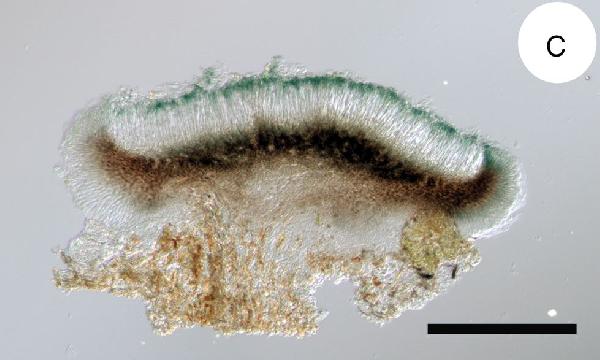
Source: Gerasimova JV, Urbanavichene IN, Urbanavichus GP, Beck A. Morphological and phylogenetic analyses of Toniniopsis subincompta s. lat. (Ramalinaceae, Lecanorales) in Eurasia. The Lichenologist. 2021;53(2):171-183. doi:10.1017/S0024282921000013 - CC BY-NC-ND 4.0
T. dissimilis. colourless rim of exciple; lateral part brown, mainly attached to hymenium, partly with blue tinge near hymenium (M-0290431, JG148)- Scale: 200 μm
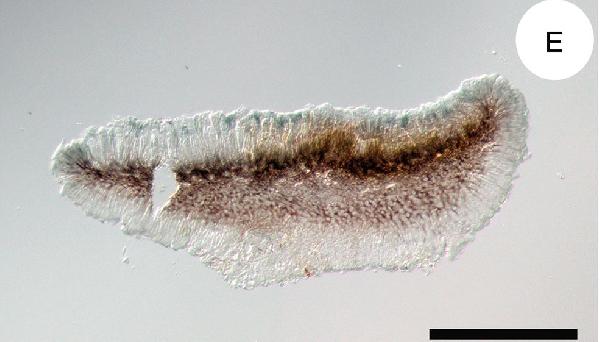
Source: Gerasimova JV, Urbanavichene IN, Urbanavichus GP, Beck A. Morphological and phylogenetic analyses of Toniniopsis subincompta s. lat. (Ramalinaceae, Lecanorales) in Eurasia. The Lichenologist. 2021;53(2):171-183. doi:10.1017/S0024282921000013 - CC BY-NC-ND 4.0
T. dissimilis. dark brown hypothecium, merging into coloration of exciple below (L-15293, JG153) - Scale: 200 μm
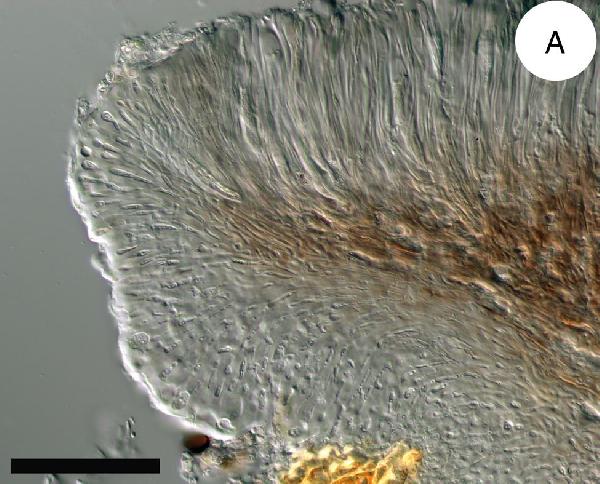
Source: Gerasimova JV, Urbanavichene IN, Urbanavichus GP, Beck A. Morphological and phylogenetic analyses of Toniniopsis subincompta s. lat. (Ramalinaceae, Lecanorales) in Eurasia. The Lichenologist. 2021;53(2):171-183. doi:10.1017/S0024282921000013 - CC BY-NC-ND 4.0
Exciple structure. A, holotype of Toniniopsis dissimilis (M-0290432, JG149) with at least 3 layers of enlarged lumina cells - Scale: 50 μm
Growth form: Crustose
Substrata: bark
Photobiont: green algae other than Trentepohlia
Reproductive strategy: mainly sexual

Predictive model

Source: Gerasimova JV, Urbanavichene IN, Urbanavichus GP, Beck A. Morphological and phylogenetic analyses of Toniniopsis subincompta s. lat. (Ramalinaceae, Lecanorales) in Eurasia. The Lichenologist. 2021;53(2):171-183. doi:10.1017/S0024282921000013 - CC BY-NC-ND 4.0
A, holotype of T. dissimilis (M-0290432, JG149); thallus, consisting of scattered ±rounded or flattened or subsquamulose granules, and dark apothecia with light brown margin - Scale: 0.5 mm

Source: Gerasimova JV, Urbanavichene IN, Urbanavichus GP, Beck A. Morphological and phylogenetic analyses of Toniniopsis subincompta s. lat. (Ramalinaceae, Lecanorales) in Eurasia. The Lichenologist. 2021;53(2):171-183. doi:10.1017/S0024282921000013 - CC BY-NC-ND 4.0
T. dissimilis (LE L-15293, JG153); thallus thick, warted to wrinkled. - Scale: 0.5 mm

Source: Gerasimova JV, Urbanavichene IN, Urbanavichus GP, Beck A. Morphological and phylogenetic analyses of Toniniopsis subincompta s. lat. (Ramalinaceae, Lecanorales) in Eurasia. The Lichenologist. 2021;53(2):171-183. doi:10.1017/S0024282921000013 - CC BY-NC-ND 4.0
A, holotype of T. dissimilis (M-0290432, JG149). - Scale: 200 μm

Source: Gerasimova JV, Urbanavichene IN, Urbanavichus GP, Beck A. Morphological and phylogenetic analyses of Toniniopsis subincompta s. lat. (Ramalinaceae, Lecanorales) in Eurasia. The Lichenologist. 2021;53(2):171-183. doi:10.1017/S0024282921000013 - CC BY-NC-ND 4.0
T. dissimilis. colourless rim of exciple; lateral part brown, mainly attached to hymenium, partly with blue tinge near hymenium (M-0290431, JG148)- Scale: 200 μm

Source: Gerasimova JV, Urbanavichene IN, Urbanavichus GP, Beck A. Morphological and phylogenetic analyses of Toniniopsis subincompta s. lat. (Ramalinaceae, Lecanorales) in Eurasia. The Lichenologist. 2021;53(2):171-183. doi:10.1017/S0024282921000013 - CC BY-NC-ND 4.0
T. dissimilis. dark brown hypothecium, merging into coloration of exciple below (L-15293, JG153) - Scale: 200 μm


